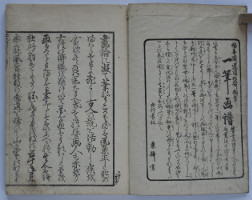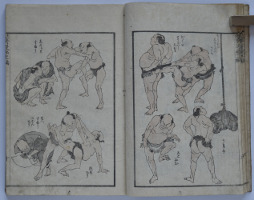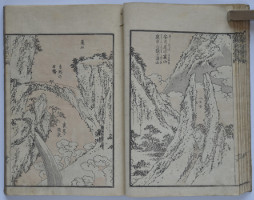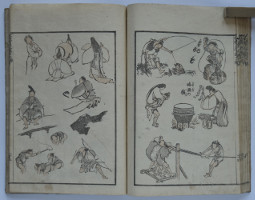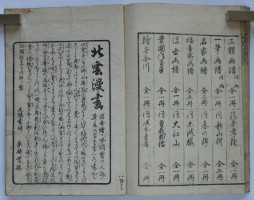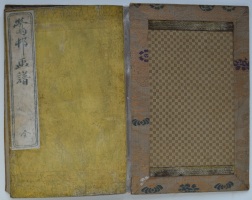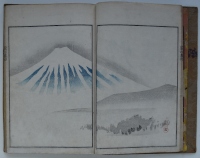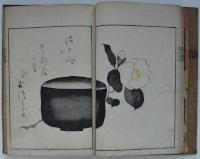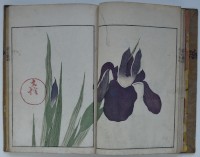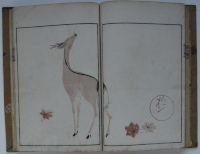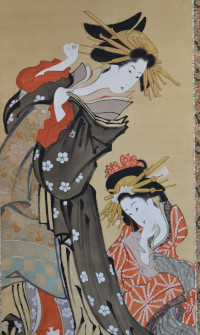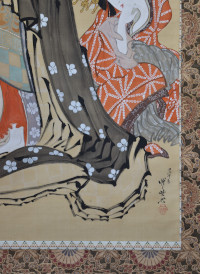Attributed to Suzuki HARUSHIGE (Shiba KOKAN 1747-1818)
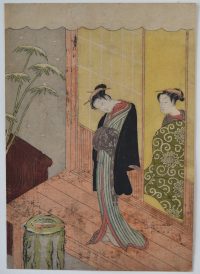
Click here to view image full size.
A winter scene with a young courtesan on an engawa gazing at an upturned ladle resting in a water basin formed from a hollow tree trunk. Behind her a young beauty peers out through the shoji. The scene calls to mind the Bell of Damnation (Muken no kane) act in the play Hiragana Seisuiki where Umegae strikes the water basin with a ladle to produce gold coins. Harushige was the ukiyo-e go of Shiba Kokan, the first artist to try copper plate engraving and who studied oil painting and etching from books he saw in Nagasaki. For a time a pupil of Harunobu whose style his prints resemble. Extremely rare: I cannot, at the moment, locate another impression. Published c early 1770s.
Fine impression. Extremely good colour, the orange pigment partly oxidised. Possibly slightly trimmed left and bottom, otherwise very good condition.
Status: Available
Tsukioka YOSHITOSHI (1839-1892)
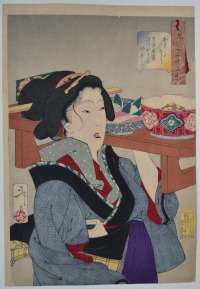
Click here to view image full size.
Omota-so: Tempo nenkan Fukagawa karuko no fuzoku, “Looking Weighed-Down: The Appearance of a Waitress at Fukagawa in the Tempo Era [1830-1844].” Shows the waitress carrying a portable wooden table with food to a geisha party from a set Thirty-two Aspects of Women published by Tsunashima Kamekichi, 1888. The set depicts women of different backgrounds and occupations from the Kansei era through to the Meiji era with punning allusions to their situation or mood.
Very fine impression of the true first edition. Fine colour and condition. Signed Yoshitoshi ga.
Status: Available
Kikugawa EIZAN (1787-1867)

Click here to view image full size.
An aiban print showing the courtesan Segawa of the Matsubaya drinking ayamezake (a sake soaked with iris root) from a set Seiro gosekku, “Beauties of the Yoshiwara Compared to the Five Festivals.” In this case the Boys’ Festival held on the 5th May. Published by Iseya Soemon, c 1810.
Fine impression, very good colour and condition. Signed Kikugawa Eizan fude.
Status: Available
Okumura MASANOBU (1686-1764)

Click here to view image full size.
One of the most influential and innovative print designers, publishers and painters. He is also credited with inventing the hashira-e as well as being the first to use multiple-block printing. A wide hashira-e (habahiro hashira-e, 24 x 6 in; 61 x 15 cms) showing the actor Sanogawa Ichimatsu I. Masanobu designed a number of prints showing this popular actor who started the fashion for the hisobi pattern on his costume which is now called the Ichimatsu moyo. Published by Masanobu c 1741. Rare.
Fine impression. Hand-applied colour: yellow, light red and light orange. Slight fading, otherwise very good condition. Signed Hogetsudo shomei Okumura Bunkaku Masanobu shohitsu, “Truly published by Hogetsudo and true brush by Okumura Masanobu” with seal Tanchosai.
Status: Available
Tsukioka YOSHITOSHI (1839-1892)
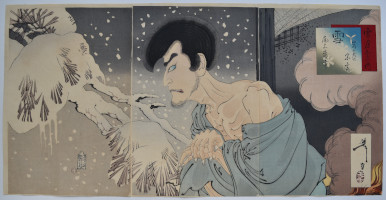
Click here to view image full size.
A triptych showing the priest Iwakura Sogen in a snowy garden. “Snow” from a set of three half-length portraits of actors with title: Setsugekka no uchi, “Snow, Moon, and Flowers.” Sogen was infatuated with the beautiful courtesan Irokotohime. He broke his vow of chastity and was expelled from his temple. Unfortunately, Irokotohime dies and Sogen is left with just his memories. There are other versions of this story and a play with the actor Onoe Baiko V. Published by Akiyama Buemon, 1890.
Fine impression of the first edition with variegated and unaltered sub-cartouche. Fine colour and condition. Signed Yoshitoshi ga.
Status: Available
Utagawa KUNISADA (1786-1865)
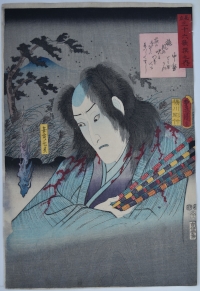
Click here to view image full size.
The actor Onoe Kikugoro III as the ghost of Yasukata from a set Mitate sanjurokkasen no uchi, “An Imaginary Thirty-six Poets.” A famous early compilation; in this case the image is inspired by a poem of Nakatsukasa.The ghost haunted the ruined palace of Soma at Sashima. Published by Iseya Kanekichi, 1852.
Fine early impression. Fine colour. Very small binding holes and slight discolouration at left edge, otherwise very good condition. Signed Toyokuni ga.
Status: Available
Watanabe SEITEI (SHOTEI) (1851-1918)
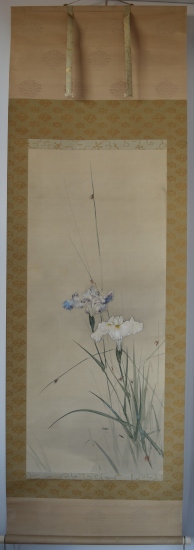
Click here to view image full size.
A large original painting, full colour on silk. Image size 47.25 x 20 in; 120 x 51 cms. Shows Japanese water iris with water striders. Seitei is best known as a kachoga (“bird and flower”) artist. He was technically brilliant showing realistic detail in a Japanese style but with Western sensibilities absorbed while living in Paris and he was, in fact, the first Nihonga artist to reside in Europe. A winner of many prizes during his life. Also published Seitei kacho gafu, 1890-91; Kacho gafu, 1903; Seitei kacho, 1916.
Signed and sealed Shotei. Very good condition. (This painting makes an excellent pair with the following offering although the mount sizes are slightly different.)
Status: Available
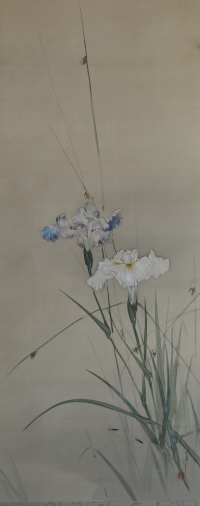
Click here to view image full size.
Watanabe SEITEI (SHOTEI) (1851-1918)

Click here to view image full size.
A large original painting, full colour on silk. Image size 47.25 x 20 in; 120 x 51 cms. Shows Japanese water iris with a snail. Seitei is best known as a kachoga (“bird and flower”) artist. He was technically brilliant showing realistic detail in a Japanese style but with Western sensibilities absorbed while living in Paris and he was, in fact, the first Nihonga artist to reside in Europe. A winner of many prizes during his life. Also published Seitei kacho gafu, 1890-91; Kacho gafu, 1903; Seitei kacho, 1916.
Signed and sealed Shotei. Very good condition. (This painting makes an excellent pair with the above offering although the mount sizes are slightly different.)
Status: Available
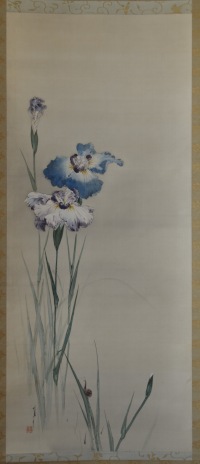
Click here to view image full size.
Utagawa KUNIYOSHI (1797-1861)
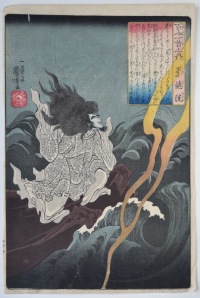
Click here to view image full size.
A poem by the celebrated poet Sutoku-in from the series Hyakunin isshu no uchi, “One Hundred Poems for One Hundred Poets” which was compiled in 1235 by Fujiwara Teiki (1162-1241). Shows the exiled Emperor Sutoku (1119-64) standing on a rocky outcrop above turbulent rapids. His wrath causes a thunderstorm with lightening. One of the very best designs from the set. Published by Ebisuya Shoshichi, Ebine, 1840-42. Only 58 of the 100 prints are known. Various translations of the poem exist, here is one:
Because the current is swift
Even though the rapids
Blocked by a boulder
Are divided, like them, in the end
We will surely meet, I know
Very fine impression. Fine colour. Very good condition. Signed Ichiyusai Kuniyoshi ga.
Status: Available
Tsukioka YOSHITOSHI (1839-1892)
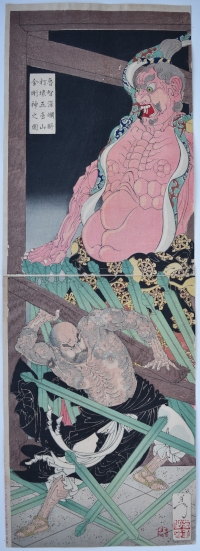
Click here to view image full size.
A vertical diptych showing Rochishin demolishing the temple gate on Mount Godai. There are conflicting versions of this event: Some suggest he gained entry to kill a gang of thieves. However, it seems that he was drunkenly staggering back to the temple after consuming a large quantity of wine and is barred entry by the monks. In a temper he demolishes the entrance and the large Buddhist guardian figure (Kongojin). The abbot dismisses him and sends him to a lesser temple. Rochishin ransui Godaisan Kongojin o uchikowasu no zu, “Picture of Rochishin in a Drunken Rage Demolishing a Guardian Statue (Kongojin) on Mount Godai.” Published by Matsui Eikichi, 1887. He figures in the Chinese classic Tales of the Water Margin, the Suikoden (jp. Suikoden) and is often referred to as the “Flower priest” because of his floral tattoos.
Very fine impression: This is the earliest state with a pigment used on the guardian’s torso that does not oxidise. (Exactly the same can be seen on the first editions of the Kinryusan Temple at Asakusa from Hiroshige’s 100 Views of Edo. Later printings use a different pigment on the huge lantern that oxidises badly.) It was also republished by Shimizuya Tsunejiro. Extensive burnishing. Fine colour. Very good condition. Signed Yoshitoshi.
Status: Available
Toyohara CHIKANOBU (1838-1912)
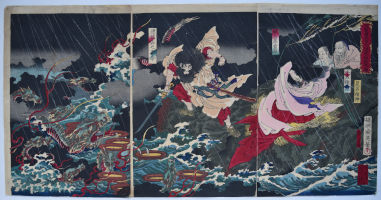
Click here to view image full size.
A triptych showing the Shinto Storm God Susanoo about to slay the eight-headed dragon, Yamata no Orochi, at the head of the Hi River in pouring rain. The dragon devoured virgins and had eaten the seven daughters of two earthly deities, seen top right. The eighth, Kushi-inada-hime, also on the right, is saved by Susanoo who encourages the dragon to drink eight-times brewed sake from eight vats which intoxicates it enough to be killed. Rare: Chikanobu is not known for this type of subject. Published c 1870s.
Fine impression, colour and condition. Mica applied to sky and the rain printed in silver. Full size. Signed Yoshu Chikanobu hitsu.
Status: Available
Tsukioka YOSHITOSHI (1839-1892)
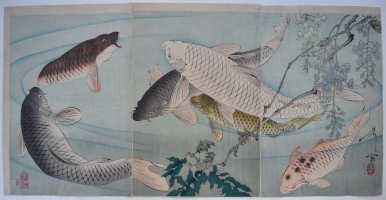
Click here to view image full size.
A triptych showing carp swimming beneath wisteria. A rare and extremely unusual subject in Yoshitoshi’s canon of work. Koi are symbols of love and friendship in Japan. The breeding of ornamental carp began in the 1820s. The outside world was unaware of the advances in breeding colour variations until an annual exposition in Tokyo in 1914. Published by Akiyama Buemon, 1889. There is an original drawing, most likely for this triptych, elsewhere on this site. A much sought after design.
Very fine impression. Fine colour. Completely untrimmed with the extra margins around. Fine condition. Signed Yoshitoshi ga.
Status: Available
Keisai EISEN (1790-1848)
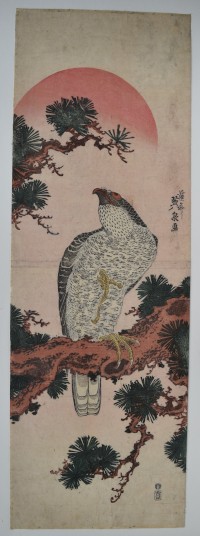
Click here to view image full size.
A vertical double oban showing a falcon on a pine branch with a large red sun above. This was a very popular subject and many artists produced versions in different formats. However, I cannot, at the moment, locate another impression of this design. Published by Kawaguchiya Uhei, c 1830s. Extremely rare.
Fine impression and colour. Slight soil and several expertly repaired wormholes, but otherwise very good condition. Signed Keisai Eisen ga.
Status: Available
Keisai EISEN (1790-1848)
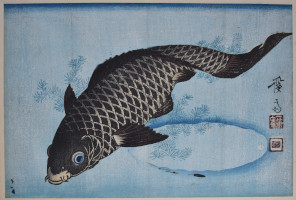
Click here to view image full size.
A carp swimming among water-weed. The moon’s reflection in the blue water. There are various editions of this design: without the moon’s reflection; with and without the censor seal; with and without publisher’s seal; with and without currents in the water. Published by Ezakiya, c. 1843-6. Rare.
Fine impression and colour. Faint vertical folds and two areas of sumi, otherwise very good condition. Signed Keisai with seals Ippitsuan and Keisai.
Status: Available
Ichiryusai HIROSHIGE (1797-1858)
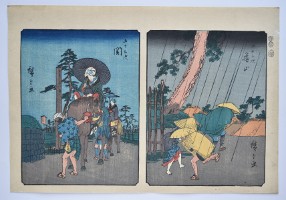
Click here to view image full size.
Seki and Kameyama from the chuban Muraichi Tokaido. The set of 56 prints published by Muraichi, 1852. Printed two-to-a-sheet uncut and probably from a complete proof set. Double censor’s seals Murata and Kinugasa and date seal 2ic/1852 top right.
Fine impressions with strong woodgrain showing. Fine colour. Very small binding holes in right border, otherwise fine condition. Signed Hiroshige ga on each print.
Status: Available
Utagawa KUNIYOSHI (1797-1861)
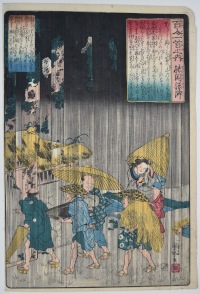
Click here to view image full size.
A poem by the celebrated poet and monk Noin-hoshi from the series Hyakunin isshu no uchi, “One Hundred Poems for One Hundred Poets” which was compiled in 1235 by Fujiwara Teika (1162-1241). A group of travellers are caught in a torrential downpour. One of the best designs in the set published by Ebisuya Shoshichi, Ebine, 1840-42. Only 58 of the 100 are known. Various translations of the poem exist, here is one:
The maples and leaves
Of Mount Mimura –
Making the Tatsuta River
A fine brocade
Very fine impression. Fine colour. Slight nibbling on one margin, otherwise fine condition. Signed Ichiyusai Kuniyoshi ga.
Status: Available
Utagawa KUNIYASU (1794-1832)
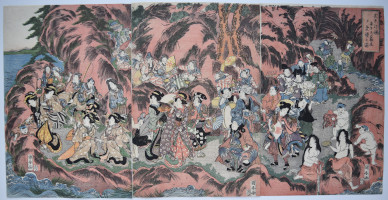
Click here to view image full size.
A triptych Soshu Enoshima Benzaiten Iwaya narabi sairei no zu, “Picture of Iwaya, the Main Shrine, Pilgrims to the Display of Benzaiten at Enoshima.” Enoshima island was a popular place to visit with the Iwaya caves and the shrine of the Buddhist goddess Benzaiten (Benten), goddess of the arts, entertainment and wealth, and one of the Seven Gods of Good Fortune. A fascinating print showing a multitude of various visitors. Published by Kawaguchiya Uhei, late 1820s. Rare.
Fine impression, colour and condition. Signed Kuniyasu ga.
Status: Available
Katsushika HOKUSAI (1760-1849)
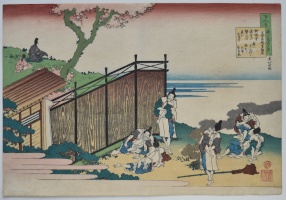
Click here to view image full size.
Hokusai’s interpretation of a poem by Onakatomi no Yoshinobu Ason (921-991). From an unfinished set: Hyakunin isshu uba ga etoki, “Pictures of One Hundred Poems by One Hundred Poets Explained by the Nurse.” The poems are from an anthology Hyakunin isshu, “One Hundred People, One Poem Each” compiled by the poet Fujiwara no Teika (1162-1241). The poet speaks of his love as being like the fire kept by the guards at the gate to the Imperial Palace: It burns hot only at night. There is actually some doubt that the poem can be attributed to Yoshinobu. Shows a group of off-duty Imperial carriage guards relaxing around the smoking embers of a fire. The poet with his servant is seen sitting on the distant hill. Published by Eijudo, 1835-36. A considerable number of original drawings exist for the set that were not turned into prints and are in various museums and private collections.
Fine impression, colour and condition. Signed Saki no Hokusai Manji.
Status: Available
Utagawa HIROSHIGE (1797-1858)
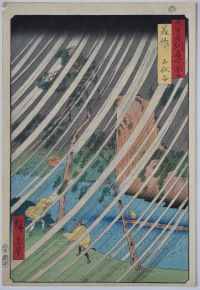
Click here to view image full size.
Mimasaka, Yamabushidani, “Mimasaka [Province], Yamabushi Valley.” Travellers caught in heavy wind and rain in the valley. Hiroshige II also produced an excellent version of this design. From a set of 69 prints [Dai Nihon] Rokujuyoshi meisho zue, “Famous Places in the Sixty-odd Provinces [of Japan]” published by b Koshimuraya Heisuke between 1853 and 1856, this being 1853.
Very fine impression and colour. Light album backing and very small wormhole at extreme edge of margin, top left, otherwise fine condition. Signed Hiroshige ga.
Status: Available
Utagawa KUNIYOSHI (1797-1861)
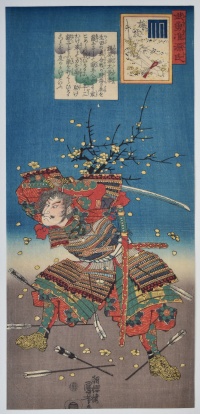
Click here to view image full size.
Chapter 32: Umegaye, “Plum brach” from an o-tanzaku set: Buyu nazorae Genji, “Heroic Comparisons for the Chapters of Genji.” Shows the Minamoto samurai Kajiwara Genda Kagesuye (1162-1200) fighting at Ikura-no-mori during the Genpai wars between the Taira and Minomoto clans. He has a plum branch stuck in his utsubo “quiver” in honour of his love Umegaye. The branch makes him an easy target for his enemies but he fights on regardless. Published by Ibaya Sensaburo, c 1843.
Very fine impression. Fine colour. Slightly trimmed at bottom, otherwise fine condition. Signed Cho-o-ro Kuniyoshi ga.
Status: Available
Tsukioka YOSHITOSHI (1839-1892)
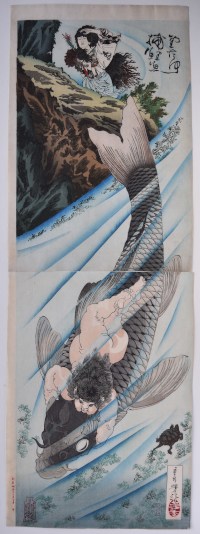
Click here to view image full size.
Kintaro rigyo o toru, “Kintaro Captures the Carp.” The “golden boy” of superhuman strength, a.k.a. Sakata no Kintoki and Kaidomaru, grapples with a giant carp which had been terrorizing the neighbourhood. There are conflicting stories about Kintaro’s origins but he is normally shown with his mother, Yama-uba, on Mount Ashigara where he developed a friendship with the mountain animals. The carp is associated with enormous strength and consequently needed great power to overcome it. From a set of fine vertical diptychs published by Matsui Eikichi, this design in 1885. It was republished by Hasegawa Tsunejiro in 1897. Arguably the best print from the set and one of Yoshitoshi’s finest designs.
Fine impression. Very good colour and condition. With full margins: This set often comes with the left margin, with the publication date, trimmed off. Signed Oju Yoshitoshi ga..
Status: Available
Kitagawa UTAMARO (1753-1806)
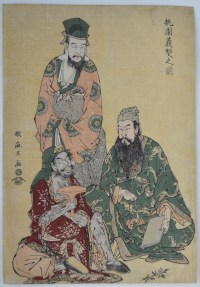
Click here to view image full size.
A scene taken from the Chinese 14th century heroic novel San guo zhi yanyi, “Romance of the Three Kingdoms” attributed to Luo Guanzhong. Shows in the centre Liu Bei (Jap. Ryubei), the founder of the Kingdom of Shu, and the two warriors, Guan Yu (Kan U) on the right and Zhang Fei (Cho Hi) on the left. The three swore pledges of brotherhood in a peach orchard. Toen gikei no zu, “Picture of the Oath in the Peach Orchard. “ Published by Tsutaya Juzaburo with early signature c 1782-3. Rare.
Fine impression. Very good colour: yellow ground. Slight crease down right edge and very small wormage near top right, otherwise very good condition. Signed Utamaro ga.
Status: Available
Hosoda EISHI (1756-1829)
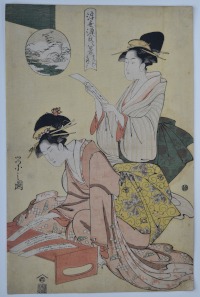
Click here to view image full size.
Two beauties examining tanzaku poetry cards from a set Ukiyo Genji hakkei, “Eight Views of Genji in the Floating World.” The designs stand alone but also form diptychs. This series compares scenes from the famous Tale of Genji novel written by the Lady Murasaki in the early 11th century with the Eight Views of Omi [Lake Biwa]. In the present case, Maboroshi rakugan (viz Katata rakugan, “Descending Geese at Katata”) is compared to chapter 41, Spirit Summoner, of the Tale of Genji where a poem composed by the Akashi Lady is in response to the grieving Genji’s poem after the nocturnal encounter with Murasaki which refers to the wild goose (aka Genji) having flown away. Published by Eijudo c 1797-99. Another impression is in the B.M., reg. no. 1931, 0427,0.8 and an impression is illustrated in Klaus J. Brandt, Hosoda Eishi, 1977, 119, no. 301. Provenance: Sold Sothebys, New York, 28/10/1980, lot 866.
Fine impression. Very good colour with yellow ground. Slight centre fold and very slight trimming, otherwise very good condition. Signed Eishi zu.
Status: Available
Tsukioka YOSHITOSHI (1839-1892)
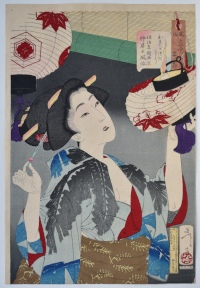
Click here to view image full size.
Okigatsuki-so: Meiji nenken saikyo nakai no fuzoku, “Looking Capable: The Appearance of a Kyoto Waitress in the Meiji Era [1867-1912].” Shows the waitress of a Kyoto geisha house whose job was to act as a go-between for customer and geisha. From a set Thirty-two Aspects of Women published by Tsunashima Kamekichi, 1888. The set depicts women of different backgrounds and occupations from the Kansei era through to the Meiji era with punning allusions to their situation or mood.
Very fine impression of the true first edition. Fine colour and condition. Signed Yoshitoshi ga.
Status: Available
Kikugawa EIZAN (1787-1867)

Click here to view image full size.
An early complete 5-sheet (pentaptych) design being a mitate-e of a daimyo’s procession along Kugenuma beach with Enoshima island and Mt. Fuji in the background. Harugasumi hana iki retsu, “Journey in the Spring Mist.” The regional feudal lords (daimyo) were required every alternative year to travel to the capital of Edo. This was a deliberately costly affair and secured their loyalty as they had to leave their families in Edo. In this design young women replace the daimyo’s retinue. Published by Kawaguchiya Uhei, 1811-14. Its rare to find 5 or 6-sheet prints complete.
Fine impression and colour. Light album backing, otherwise very good condition. Signed Kikugawa Eizan hitsu.
Status: Available
Katsushika HOKUSAI (1760-1849)
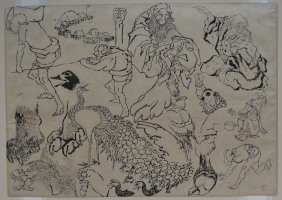
Click here to view image full size.
A sheet of original studies, sumi on thin paper, 10.5 x 15 in; 26.6 x 38 cms. Of particular interest and importance is the self-portrait in the upper right, This is another version of the famous self-portrait at the age of 83 (1842) sent to his publisher. Illustrated in Hokusai Drawings, J. Hiller, Phaidon, 1966, ill. No. 110 from the Rijksmuseum voor Volkenkunde, Leiden, Netherlands. Provenance: Ex Henri Vever collection, seal bottom right.
One small wormhole, otherwise in very good condition.
Status: Available
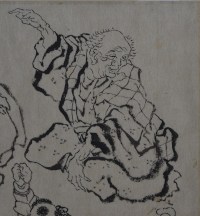
Click here to view image full size.
Katsushika HOKUSAI (1760-1849)
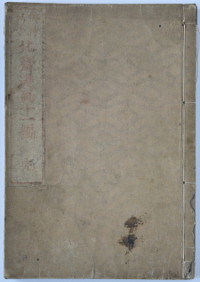
Click here to view image full size.
Volume 11 from the Manga. Front cover with original pink title slip: (Denshin kaishu) Hokusai manga juichihen, (“Transmitted from the Gods.”) “Hokusai’s Sketches, Vol. 11.” Original grey covers with burnished wave and diamond pattern. Inside front cover catalogue of newly published books; 2 pages preface and 29 numbered pages comprising 56 illustrations , 36 single page and 10 double page. 2 pages block-holders catalogue and inside back cover catalogue of newly published books. The extremely rare first edition published by Eirakuya Toshiro, Nagoya, c. 1834. The Manga was eventually completed in 15 volumes (the last two posthumously). The first 10 volumes published by Kadomaruya Jinsuke, Edo and Eirakuya Toshiro, Nagoya, 1814-1819; vols. 11 and 12 by Eirakuya only, c. 1834; vol. 13 by Eirakuya only, c. 1849; vol. 14 by Eirakuya only, c. 1850s; vol. 15 by Eirakuya only, 1878. Initially based on sketches produced on a visit to his friend and pupil Maki Bokusen in Nagoya in 1812. These sketches were collated by Bokusen and Katsushika Hoku’un and published in 1814. Other pupils collected sketches and so the set expanded. The books were enormously influential and popular, not just in Japan, but in the West and were endlessly reprinted giving rise to a plethora of late editions. In 1831, the German Phillip Franz von Siebold, reproduced images from the Manga in lithograph in his Archiv zur Beschreibung von Japon. They were also highly admired by the Impressionists, especially Manet and Bracquemond.
Fine impressions of the first edition. Some minor defects but otherwise in very good condition.
Status: Available
Maruyama OKYO (1733-1795)
Click here to view image full size.
One volume complete Okyo gafu, “Book of Paintings by Okyo.” Original covers and title slip. A large book, 11.5 x 7.5 in; 28.4 x 19.2 cms folding out to 11.5 x 15 in; 28.4 x 38 cms. Published by Hishiya Magobe. Dated 1833 but first published 1850 (dated Kaei 3 [1850] at end). Twenty-four pages of sumi illustrations based on Okyo’s paintings. Arguably the most important Maruyama-Shijo painter. A tour de force of the block-cutters’ art replicating Okyo’s brush strokes. Minor imperfections but otherwise a very nice example of this work. Mitchell, p.441, example “A.”
Status: Available
Kitagawa FUJIMARO (1790-1850)

Click here to view image full size.
An original painting, full colour on silk, image size 35.25 x 13.5 in; 89.5 x 34.5 cms. Fujimaro was a talented late pupil of Utamaro. More than a dozen paintings are recorded by him including an example in the Portland Art Museum, acc. number 69.51. His best-known work is in the collection of the Tokyo National Museum depicting Yujyo risshi-zu and another four paintings of beauties in the four seasons is in the collection of the Ota Memorial Museum of Art, Tokyo. Shows a standing courtesan beside a vase containing peonies and cherry blossom. On her sumptuous costume are the black wheels of a hanaguruma, “flower cart.” These vehicles carried baskets with often elaborate arrangements of flowers. It seems more than coincidence that the vase is placed where the basket would have been on the cart.
Painted c 1820. Signed Fujimaro with seal Yozan. Newly remounted and in fine condition with new box and futo-maki (thick wooden roll to preserve the painting from damage).
Status: Available
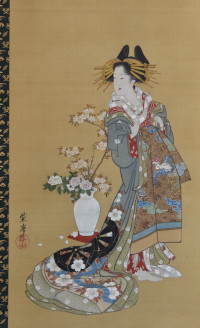
Click here to view image full size.
Kawanabe KYOSAI (1831-1889)
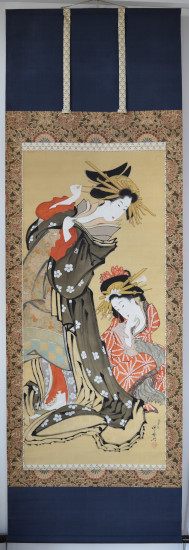
Click here to view image full size.
A large original painting, full colour on silk, image size 48 x 21.75 in; 122 x 55.25 cms. A draughtsman of great dexterity with a wild, often bizzare , imagination. Loved sake, sometimes painting under its influence. At an early stage studied under Kuniyoshi, then Maemura Towa and later Kano Chinshin before becoming an independent painter at 27. Adept at highly finshed paintings but also produced a large corpus of spontaneous paintings. Shows a standing courtesan with her kamuro. An homage to Hokusai whom he obviously admired.
Highly finished in places but also incorporating quirky elements of Hokusai’s style. Signed Hokusai hitsu-i (“Imitating Hokusai’s brush”) Shojo Kyosai. In very good condition with old double box with an untranslatable annotation on inside of lid comparing him to Hokusai. An important new discovery.
Status: Available
Ryuryukyo SHINSAI (1764-1820)

Click here to view image full size.
An original painting, sumi and light colour on silk, 32 x 11 in; 81.3 x 28 csms. Shows three classes in Japanese society: Farmer’s wife, Priest and a Samurai, forced to shelter together at the entrance to a Shinto shrine from a sudden downpour of rain. Above, a rooster and hen also shelter. These birds were allowed to roam freely around Shinto Temples. Shinsai was one of Hokusai’s best pupils. Known for his fine surimono and paintings. Signed Ryuryukyo Shinsai with Ryuryukyo seal. In good condition.
Status: Available
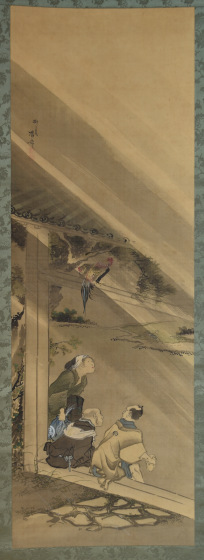
Click here to view image full size.
Utagawa KUNISADA (1786-1865)
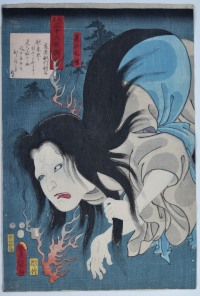
Click here to view image full size.
The actor Ichikawa Kodanji IV as the ghost of Kasane from a set Mitate sanjurokkasen no uchi, “An Imaginary Thirty-six Poets.” A famous early compilation; in this case the image is inspired by a poem of Fujiwara no Toshiyuki Ason. Shows Kasane’s vengeful ghost appearing to her husband who had murdered her. Published by Iseya Kanekichi, 1852.
Very fine early impression showing overall strong woodgrain and glue applied to the ghost’s right eye. Fine colour. Very small binding holes, otherwise very good condition. Signed Toyokuni ga.
Status: Available
Utagawa KUNISADA (1786-1865)
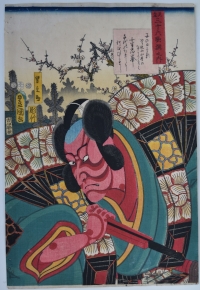
Click here to view image full size.
The actor Ichikawa Danjuro VIII as Arajishi Otokonosuke from a set Mitate sanjurokkasen no uchi, “An Imaginary Thirty-six Poets.” A famous early compilation; in this case the image is inspired by a poem of Mibu no Tadamine. Otokonosuke is usually depicted about to strike his adversary Nikki Danjo -who has turned into a rat – with an iron fan (leaving a red mark on the rat’s/Danjo’s head). Published by Iseya Kanekichi, 1852.
Very fine early impression. Fine colour. Very small binding holes, otherwise very good condition. Signed Toyokuni ga.
Status: Available
Utagawa KUNISADA (1786-1865)
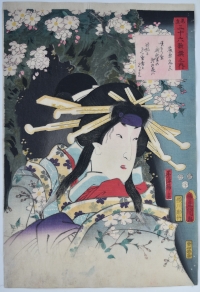
Click here to view image full size.
The actor Segawa Kikunojo III as the Spirit of the Komachi Cherry Tree from a set Mitate sanjurokkasen no uchi, “An Imaginary Thirty-six Poets.” A famous early compilation; in this case the image is inspired by a poem of Fujiwara no Motozane. The spirit is the courtesan Kurozome who appears to combat the evil plans of Sekibei (actually Otomo no Kuronushi) to cut the tree down. Published by Iseya Kanekichi, 1852.
Fine impression. Fine colour. Very small binding holes otherwise very good condition. Signed Toyokuni ga.
Status: Available
Utagawa HIROSHIGE (1797-1858)
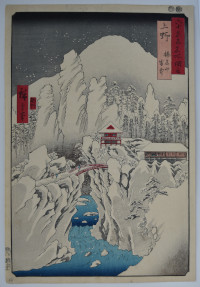
Click here to view image full size.
Kozuke, Harunasan setchu, “Kozuke [Province], Mount Haruna Under Snow.” From a set of 69 prints [Dai Nihon] Rokujuyoshi meisho zue, “Famous Places in the Sixty-odd Provinces [of Japan]” published by Koshihei between 1853 and 1856, this being 1853. A red bridge spans a gorge with precipitous cliffs and a fast flowing river. Fantastic crags point upwards into the sky. In the distance is Mount Haruna – a sleeping volcano.
Very fine impression and colour. Light album backing, otherwise fine condition. Signed Hiroshige ga.
Status: Available
Utagawa HIROSHIGE (1797-1858)
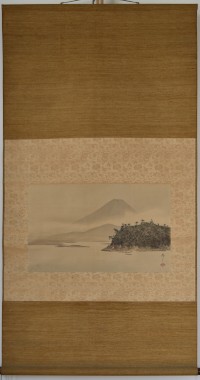
Click here to view image full size.
An original painting, sumi and light colour on silk, 11 x 18 in; 28 x 45.75 cms. Shows the sea off the Miura Peninsula in Sagami Province with Mount Fuji rising above mist in the distance. Hiroshige used the same view for one of his designs for the Thirty-six Views of Fuji set published in 1858. A beautiful painting with a signature dating it to the mid to late 1830s.
Minor creasing and old mount, otherwise good condition. Signed Hiroshige with Hiro seal.
Status: Available

Click here to view image full size.
Suzuki HARUNOBU (1724-1770)
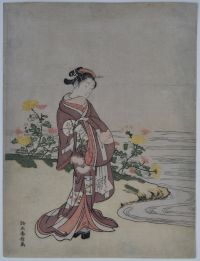
Click here to view image full size.
A beauty standing beside a stream where wild chrysanthemums grow. A mitate-e (parody) of Kikujido, the Chrysanthemum Boy, who was the favourite of the Chinese Emperor Mu (c. 950 B.C.). However, because of court jealousy, he was banished but had his exile eased by the Emperor who gifted him the ability to read sacred Buddhist texts. He became an immortal, spending his days surrounded by chrysanthemums and inscribing words of peace on the flowers’ petals. This is the second state: The first (private edition) is a calendar print with a signature (of an amateur) Kinga Ko and seal and has the year and its cyclical signs for 1766. These Harunobu calendar prints, printed in small numbers, were commissioned by wealthy individuals between c. 1764 and 1766 and so popular that they were published commercially. Rare.
Very good impression and colour Very minor edge soil, otherwise very good condition. Signed Suzuki Harunobu ga.
Status: Available
Utagawa KUNISADA (1786-1865)
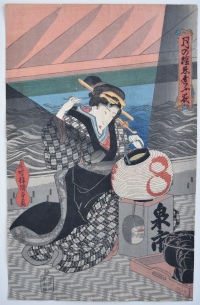
Click here to view image full size.
A geisha partly illuminated by a lantern on a boat from a set Tsuki no kage shinobiau yo, “Secret Meetings by Moonlight.” Published jointly by Izumiya ichibei (as here) and Yamamoto Kyubei, c. 1836-38.
Very good impression and colour. Minor creasing, otherwise very good condition. Signed Kochoro Kunisada ga.
Status: Available
